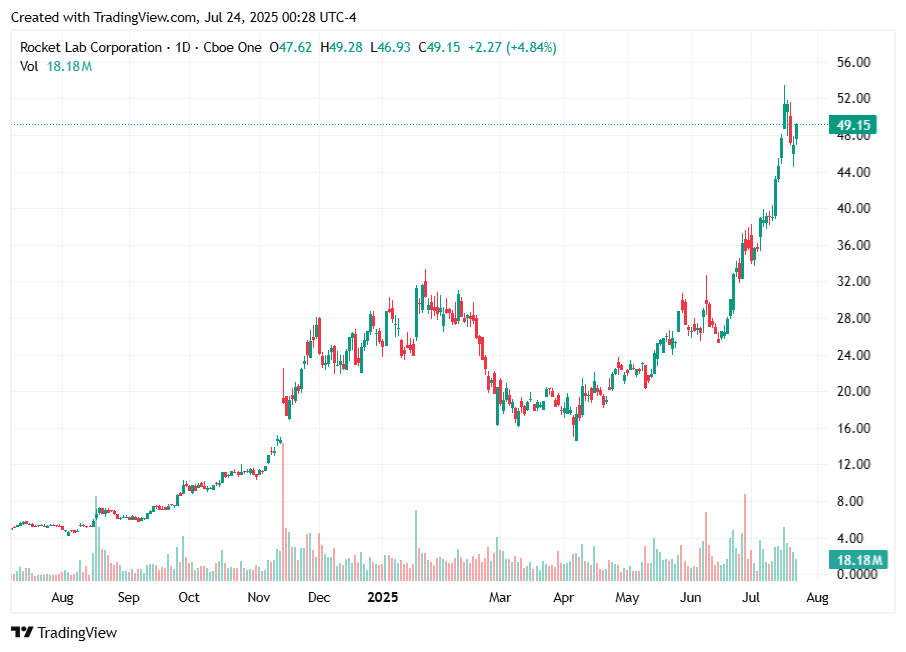Rocket Lab’s Financial Trajectory
We’re looking at Rocket Lab’s profits, revenues, and costs to see how sustainable their strategy is.
This article presents our views and analysis only and does not constitute investment advice or a recommendation.
In our previous article, we explored Rocket Lab’s products and market position. This time, we turn our attention to the company’s financials — where the story shifts from products to hard numbers.

Rocket Lab just proved that space isn’t a future dream — it’s a booming business today, smashing $436M in last year's revenue by blending rocket launches with satellite tech like a true space powerhouse.
Revenue Breakdown
Rocket Lab’s revenue comes from two core segments:
Launch Services – based on Electron and (soon) Neutron rocket launches
Space Systems – satellite components, complete spacecraft platforms, and mission services
Space Systems has become the dominant revenue contributor in recent years. However, the current backlog tells a different story, signaling shifts in Rocket Lab’s growth dynamics that are worth exploring in more detail.
Rocket Lab’s Revenue Growth Journey (2020–2024)
Company’s revenue story shows how the company grew from a focused rocket launch provider into a full-fledged space systems player. In the early days, most of the growth came from more frequent launches and early satellite projects. Later, things really took off as Rocket Lab expanded into broader space systems. Growth then leveled out a bit as the company matured — but in recent years, it picked up again thanks to scaling, new contract wins, and a wider range of services. Here's how that journey looks in numbers and per segment:
2020–2021: Getting Off the Ground (↑77%)
Rocket Lab grew from $35M to $62M as more customers started trusting Electron for small satellite launches. Space systems started contributing revenue for the first time, showing the first signs of a more integrated business model.
2021–2022: The Big Leap (↑239%)
Revenue exploded to $211M — mostly thanks to a massive jump in satellite manufacturing. Space systems grew over 500% as Rocket Lab moved beyond launches and started delivering full-stack space solutions.
2022–2023: Steady Climb (↑16%)
Growth slowed to $245M. Launch and satellite services both kept growing, but this was a year of scaling up operations and laying the groundwork for what’s next.
2023–2024: Back in High Gear (↑78%)
Revenue surged to $436M. Both launch and space systems grew strongly, boosted by big contracts, more launch cadence, and demand for satellite constellations. Rocket Lab’s dual-engine model really started to show its strength here.
Each year shows a slight increase in the percentage of launch services, and this trend is expected to continue based on the current backlog.
Cost Efficiency: Rocket Lab's Secret Engine Isn’t Just Rockets — It’s Efficiency
Rocket Lab has been investing heavily from the start, so its costs have often outpaced revenue — and that’s still true today. That’s normal for a company still ramping up. Back then (in 2020), the cost of revenue was 134% of sales.
Fast forward to 2024, and that number has dropped to just 73%. That’s a big shift — and it shows that Rocket Lab is getting more efficient as it grows.
What’s driving this improvement?
Scaling up: More launches and satellite deliveries mean better economies of scale. Costs per unit drop when you’re producing and launching more often.
Doing it all in-house: Rocket Lab controls much of its supply chain — from components to launch pads — which helps cut costs and protect margins.
Getting better with time: More experience means smoother operations, fewer delays, and more efficient production across the board.
By 2023 and especially 2024, the company wasn’t just growing revenue — it was doing so more profitably, which we will touch on in the profitability section.
Rocket Lab’s R&D spend has grown 9x from 2020 to 2024, driven by the development of key technologies:
Neutron rocket development: The next-generation, medium-lift rocket requires heavy upfront engineering costs.
Spacecraft platforms & components: Expansion into satellite buses, propulsion systems, and mission software has required sustained innovation.
Defense & deep space tech: R&D includes work on advanced payloads, interplanetary missions, and national security projects.
Despite revenue growing significantly, R&D as a percentage of revenue has remained high (40%+ in four of five years 2020-2024), showing Rocket Lab’s long-term commitment to innovation and platform expansion.
Rocket Lab has implemented cost-saving measures such as robotic manufacturing systems and 3D printing to streamline production processes and reduce expenses. These innovations have contributed to the overall cost efficiency of the Electron rocket.
Rocket Lab depends on critical materials like carbon fiber composites, rare elements for solar cells and avionics, and specialty chemicals for propulsion. During 2024 and into 2025, prices for some materials rose moderately due to supply chain constraints and volatile energy markets, adding some cost pressure.
The company’s vertical integration of key components—such as propulsion systems, avionics, and solar arrays—helps mitigate these cost increases by controlling manufacturing internally. However, certain specialized sensors and commodity parts continue to be sourced externally.
Also, a large part of production takes place in Australia, which provides a strategic advantage by reducing exposure to tariffs and global supply chain disruptions, helping to stabilize overall costs despite market fluctuations.
Keep reading with a 7-day free trial
Subscribe to Cyclop SpaceTech to keep reading this post and get 7 days of free access to the full post archives.




